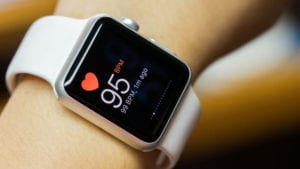Nowadays, we always see friends share their activity data on social media, such as daily steps or walking distance. People use data in wearable devices to prove that they live healthily, but they didn’t realize that this type of technology becomes a part of their lives. Just as Benjamin Bratton says, “the city wears us,” machines unconsciously influence people. They not only extend our sensing but also become a part of our “skin.” Of course, wearable devices can’t represent the smart city, but it is a good example of artificial intelligence.
Every iPhone user has an app called Health. It summarizes users’ everyday health data such as average sleep hours, Walking + running distance, steps, and even step length. It also analyzes the data to build users’ health profiles. Many users love those numbers to know how many hours they sleep last month and their running distance in the past week. However, it’s also scary when machines know us better than we know about ourselves. Similarly, wearable devices such as the Apple Watch and Fitbit have sensors that monitor and track heartbeat or glucose levels when people wear clothes. For example, such device uses a tuned algorithm to detect unique motion patterns. Those patterns must meet the specific requirements in the pre-set algorithm. Apple Watch uses a technology called photoplethysmography or PPG to measure heart rate. It will test how much red or green light the device can see when looking at the skin on the wrist.
Wearable devices are like the new skin that extend our sensory system, but people who use the same device share the same sensory system. Just as Benjamin says, “the flexibility and ubiquity of these sensors is also a function of the platformization of components and sub-components across applications, and the distribution of the same or similar sensors across unlike surfaces means that very different kinds of bodies share the same sensory systems.” Sensors in wearable devices provide key metrics to collect and predict health data, but they create an invisible platform that allows companies to use those data in other places. The health data is private to users, but it is open to wearable technology owners. Therefore, when consumers use Fitbit or Apple Watch, they share their “skin” with others. Besides, smartwatches and Fitbit have become a symbol of a healthy lifestyle. People who love exercise love to wear Fitbit or similar products because they are used in social contexts to represent their identities. It defines who they are. Similarly, white-collar workers love to wear Apple Watch because it looks professional and has different functions representing who they are. If we back to the old debate of whether AI can compete with human beings, it may show that machines can’t compete with humans, but they controlled us. Technology not only shapes our daily lives but also changes how we think about ourselves.


Leave a Reply